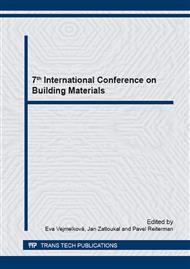p.111
p.117
p.121
p.127
p.133
p.139
p.145
p.151
p.155
Effect of CO2 Exposure on Mechanical Resistivity of Cement Pastes with Incorporated Ceramic Waste Powder
Abstract:
Carbonation is chemical process associated with CO2 penetration into the material porous structure causing subsequent chemical changes in the structure of cement pastes. In this work, carbonation of several pastes containing varying amount of cement replacement by three waste ceramic powders is studied. Chemical composition of particular tested materials is accessed using XRF analysis. Matrix density, bulk density, total open porosity, compressive and bending strength are measured for all developed pastes with incorporated ceramic materials. Simultaneously, the effect of carbonation on these material properties is researched. The obtained results show significant improvement of materials mechanical strength due to the carbonation. Here, the measured compressive strength is typically about ~ 60% higher for materials exposed to CO2 rich environment compared to the materials cured in laboratory conditions.
Info:
Periodical:
Pages:
133-137
Citation:
Online since:
July 2015
Authors:
Price:
Сopyright:
© 2015 Trans Tech Publications Ltd. All Rights Reserved
Share:
Citation:


